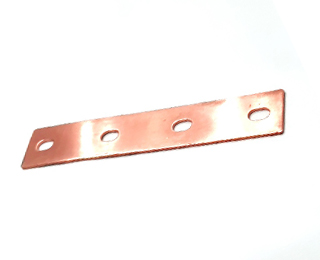2025-03-07 17:14:58
Bus Bar Copper is a crucial component in electrical power distribution, known for its excellent conductivity, durability, and versatility. Used extensively in industries such as power generation, automotive, renewable energy, and industrial manufacturing, Copper Bus Bars provide an efficient and reliable solution for electrical connections.This article explores the characteristics, applications, and benefits of Copper Bus Bars in modern electrical systems.

A bus bar is a solid or laminated strip of copper used for conducting electricity within a system. Copper is the preferred material due to its high electrical conductivity, corrosion resistance, and mechanical strength. These bus bars come in various shapes, including flat, rectangular, or custom-designed profiles, to meet specific application needs.
Copper Bus Bars are often used as an alternative to traditional wiring in high-power electrical systems, reducing energy loss and improving efficiency.
Copper has an electrical conductivity of approximately 100% IACS (International Annealed Copper Standard), making it one of the best materials for power transmission. This ensures minimal energy loss and higher efficiency in electrical systems.
Copper bus bars efficiently dissipate heat, preventing overheating in power distribution networks. This is particularly important in high-current applications such as industrial switchgear and transformers.
Copper naturally resists oxidation and corrosion, ensuring longevity and reliability, even in harsh environments such as industrial plants and marine applications.
Copper bus bars can withstand mechanical stress and vibrations, making them suitable for heavy-duty applications where stability is required.
Bus bars can be fabricated in various sizes, shapes, and thicknesses, allowing for customized electrical solutions. They can also be coated with tin, silver, or nickel plating to enhance performance in specific environments.
Copper bus bars are widely used in electrical panels, switchboards, and power distribution systems to efficiently transmit electricity with minimal resistance. Their ability to handle high currents makes them essential for electrical substations and power grids.
In solar power plants and wind energy farms, copper bus bars serve as conductors in inverters, battery storage systems, and substations. Their efficiency helps maximize energy transfer from renewable sources.
Copper bus bars play a critical role in electric vehicle (EV) battery systems, power electronics, and charging stations. Their ability to handle high power loads with minimal energy loss makes them ideal for EV applications.
Manufacturing facilities and heavy industries use copper bus bars in motor control centers (MCCs), transformers, and automation equipment. Their reliability ensures uninterrupted power supply to critical systems.
With the growing demand for high-performance computing, data centers use copper bus bars to distribute power efficiently across servers and network infrastructure, reducing downtime and improving operational efficiency.
High-speed trains, metro systems, and railway electrification rely on copper bus bars for traction power, signal systems, and auxiliary power distribution, ensuring smooth and reliable operation.
| Feature | Copper Bus Bars | Traditional Wiring |
|---|---|---|
| Conductivity | High electrical efficiency | Higher resistance and energy loss |
| Heat Dissipation | Efficient thermal management | Can overheat in high-power applications |
| Space-Saving | Compact and organized | Bulky and difficult to manage |
| Durability | Long-lasting, corrosion-resistant | Prone to wear and degradation |
| Customization | Available in various shapes and coatings | Limited design flexibility |
| Installation | Easy to install and maintain | Requires complex wiring management |
Copper bus bars enhance system efficiency, reduce maintenance costs, and improve safety, making them a preferred choice over traditional cabling in high-power applications.
Advancements in tin, silver, and nickel plating improve the longevity and conductivity of copper bus bars, especially in demanding environments like marine, automotive, and industrial sectors.
Modern power grids and industrial automation systems are integrating IoT-based monitoring with bus bar systems for real-time performance analysis and fault detection.
New manufacturing techniques, such as hollow and laminated bus bars, help reduce weight while maintaining high electrical efficiency, especially for electric vehicle (EV) applications.
With the rapid growth of solar and wind energy, copper bus bars are increasingly used in inverters, battery storage, and energy management systems, ensuring maximum power output with minimal loss.
Copper bus bars are indispensable components in modern electrical power distribution, offering high efficiency, durability, and flexibility. Their widespread use in power grids, renewable energy, automotive, and industrial applications highlights their importance in improving energy efficiency and system reliability.
As technology evolves, copper bus bars will continue to play a vital role in enhancing electrical infrastructure, supporting renewable energy transitions, and enabling the future of electric mobility.